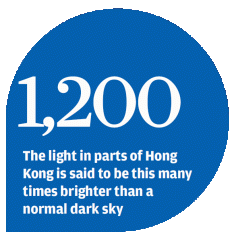
Higher rent may be the price for a good night’s sleep
The market has found its own way of dealing with light pollution in Hong Kong, where higher rents may be the price for a good night's sleep
Nobel laureate Ronald Coase, who died last year, left a profound mark on the field of economics. The Coase Theorem holds that people who place the highest value on a good or service will get to use it.

His theorem can be illustrated with a simple example. Cars produce pollution and impose a disutility or cost on victims. But a prospective car owner often considers only the utility he derives from driving. As a consequence, there may be too many cars on the road. The standard solution before Coase's work on social cost was to tax the car owner for the pollution caused by driving. The optimal amount of tax would be the amount sufficient to compensate victims for their loss.
This is the "polluter pays" principle first proposed by Professor Arthur Cecil Pigou in 1920. This punitive approach continues to inform the way policymakers deal with pollution.
Pigou's idea is straightforward: if each car produces $5 of disutility to each victim, assuming there are 100 victims, then the government should tax each car owner $500 and compensate each victim $5 for every car that is on the road.
Since owning a car is now $500 more expensive, only owners who derive more than this amount of utility from driving will wish to own one. If only 10 out of 20 prospective car owners can derive more than $500 in utility from driving, then there would only be 10 cars on the road; this is the optimal number of cars.
Coase, however, proposed that if the 100 victims got together and offered every car owner $500 to not drive, then only 10 prospective owners would be willing to accept this offer.
His insight is that the amount of pollution does not depend on whether government imposes a tax on car owners, or victims voluntarily choose to compensate prospective car owners for not driving. The car owners and victims are treated symmetrically. Whether society decides to make the polluters pay or let the victims pay off the polluters depends on which solution is more costly to arrange, that is, the transactions cost of getting to a solution.
The idea that victims should compensate polluters may sound odd and morally offensive. But this apparent oddness disappears if one sees that in some situations it may be a far cheaper option.
Hong Kong is believed to be the world's worst city for light pollution, with levels in Tsim Sha Tsui reportedly up to 1,200 times brighter than a normal dark sky.
The government is considering controls on neon lights to protect those living in their vicinity. What can Coase's reasoning offer on this issue?
Those least affected by it live in brightly lit neighbourhoods
The neon lights are erected by shopkeepers who rent wall space from landlords, often near domestic premises in older neighbourhoods. Those residents who were unable to adjust to the neon lights and could afford to move out have already done so.
Landlords would have lowered rents sufficiently to retain the other tenants. It would be logical to presume the remaining tenants have been compensated with lower rents.
If a new law or regulation takes effect and neon lights are ordered switched off after midnight, what would happen to rents for these now "improved" domestic premises? Landlords would raise them, because there would be less need to compensate victims for insomnia and interrupted sleep, although landlords who rent out wall space would lose rental income.
Tenants would lose out, because their improved sleep quality would unlikely compensate for higher rents. Some of these tenants work late shifts and sleep during the day. They are often low-income households. There is therefore an inherent compatibility between such tenants and their neon-lit neighbourhoods.
This is the Coase Theorem in action. People have voluntarily solved the problem of light pollution, at least in part, whereby those least affected by it live in brightly lit neighbourhoods.
In principle, everyone outside the affected neighbourhood would gain from reduced light pollution, including those living on other continents, because they would not have to bear any of the costs. The chief bearers of the higher costs are the residents, who would have to pay higher rents.
The real conflict is between different tenants living in the same neighbourhood. But a law regulating light pollution will not resolve this neighbourhood conflict.

